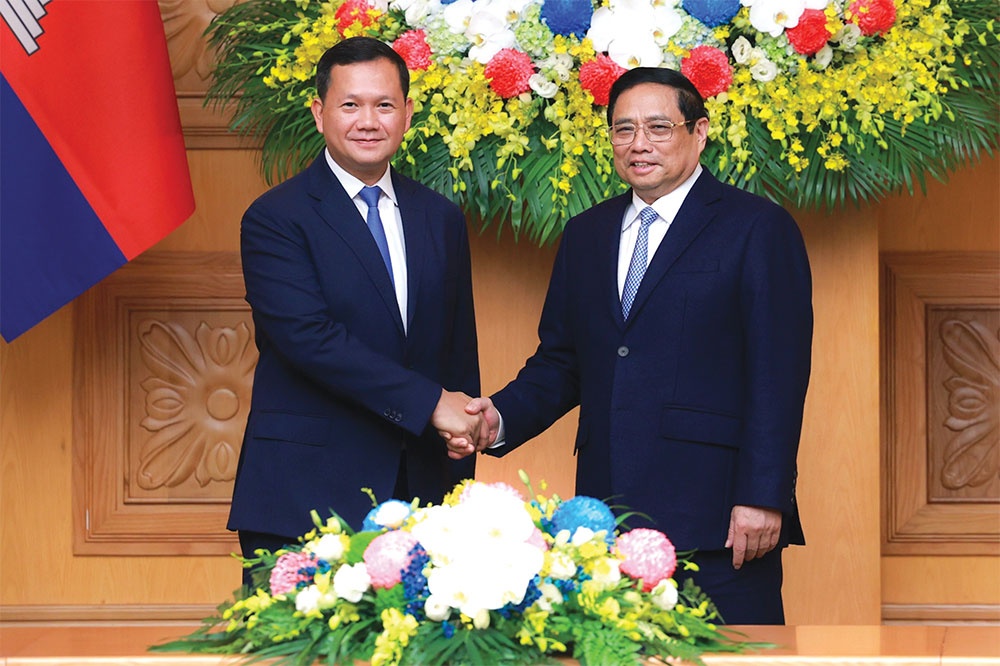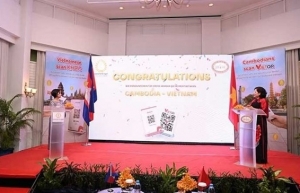New initiatives on the rise with Cambodia
At a meeting between Vietnam’s Party General Secretary Nguyen Phu Trong and Prime Minister of Cambodia Hun Manet last week, the Vietnamese leader called on the two governments to direct authorities at all levels to promote collaboration, share experience, and make breakthroughs in economic cooperation between the two economies, among other issues.
 |
| Cambodian Prime Minister Hun Manet (left) met with Vietnamese counterpart Pham Minh Chinh, Photo Duc Thanh |
Vietnam will continue its consistent policy of attaching importance to the good neighbourliness, traditional friendship, and comprehensive and long-term sustainable cooperation with Cambodia, Party General Secretary Trong said.
Extending profound thanks to Vietnam for its assistance to Cambodia in its past struggle for national liberation and in the current national development process, the Cambodian PM said that his nation will work with Vietnam “to protect, preserve, and further develop the bilateral relationship to a new height and pass it on to future generations”.
He said that Cambodia will continue working closely with Vietnam to effectively carry out treaties and agreements already reached by senior leaders, thus helping to preserve and enhance solidarity between the two.
Last week witnessed the signing of three cooperation documents between Vietnam and Cambodia, including an MoU on science, technology, and innovation cooperation between Vietnam’s Ministry of Science and Technology and Cambodia’s Ministry of Industry, Science, Technology and Innovation; one with the chambers of commerce and industry on both sides; and a third between the Diplomatic Academy of Vietnam and Cambodia’s Institute of Diplomacy and International Relations.
Other key breakthroughs were being made last week. Vietnam’s MB Bank awarded an MoU to MB Cambodia on a credit limit of $8 million, and providing a loan solution package of $12 million for customers buying homes in projects invested by KNN and Mekong Land.
Meanwhile, Vietnam’s Hung Hau Food JSC and Rithy Granite (Cambodia) were awarded an MoU for deep processing of cashew nuts and mangoes in Cambodia, worth $50 million. Moreover, Vietjet was awarded a certificate announcing direct flights between Hanoi and Siem Reap.
During the talks last week, PM Hun Manet underlined that the Cambodian government will further facilitate the performance of foreign investors, including those from Vietnam.
Expanding ties
Cambodia encourages Vietnamese investors to invest more in its market, particular in many sectors such as processing and manufacturing, high-tech agriculture, digital technology, finance and banking, and vehicle manufacturing, he stressed.
Vietnamese Prime Minister Pham Minh Chinh proposed that businesses consolidate linkages with a focus placed on finance, transport, energy, telecommunications, and tourism. They are encouraged to boost the exchange of experience in formulating policies to bettering both countries’ business investment climates.
Vietnam and Cambodia have agreed to support each other in building independent and self-reliant economies; strengthen the connectivity between the two economies, including infrastructure connectivity and policy coordination; speed up trade exchange, including border trade and formulation of border economic zones; and encourage and create new advantages for the two countries’ enterprises to expand partnership.
The two-way trade increased by over 20 per cent annually in the 2012-2022 period, exceeding $10 billion last year. In the first 10 months of this year, the figure reached $7.13 billion, with Vietnam’s exports of $4.13 billion (down 17.2 per cent on-year) and imports of nearly $3 billion (down 27.8 per cent on-year).
Vietnam has become the top ASEAN investor and one of the five-largest foreign investors in Cambodia, with 205 valid projects registered at $2.95 billion. Cumulatively as of November 20, Cambodian investors had 31 valid ventures in Vietnam worth $73.6 million.
Currently, Vietnam is constructing an expressway running from Soc Trang province’s Tran De port to An Giang province, both in the Mekong Delta region, and another running from Ho Chi Minh City to the south-eastern province of Tay Ninh. These two expressways are connected with border gates with Cambodia and other expressways.
Vietnam is also studying the construction of railways and roads to further connect it with other regional nations.
With Cambodia being Vietnam’s largest overseas investment destination, Vietnamese investors began accelerating their investments in Cambodia in 2008, with focus laid on rubber plantation, telecommunications, property, services, and banking.
Vinamilk announced that it would increase its total capital for projects in Cambodia to $42 million and will construct a dairy farm there with an annual output of over 4,000 tonnes of milk materials. Currently, Vinamilk subsidiary Angkormilk has been since 2014 operating a $23 million factory which annually produces about 50 million litres of assorted milk.
Many major Vietnamese rubber plantation projects have been implemented in Cambodia by Vietnam Rubber Group, Hoang Anh Gia Lai Group, and CT Group.
The two countries have also established an aviation joint venture, a fertiliser production facility, Metfone Telecommunications, factories to produce sugar and ethanol, and a thermal power plant inside the Cambodian territory.
Last week also saw the two countries agree to increase high-level visits and contacts, effectively implement the agreements reached by the two countries’ senior leaders, and promote the role of bilateral cooperation mechanisms, including the Joint Committee for Economic, Cultural, Scientific and Technological Cooperation and the conference on cooperation and development between border provinces.
Removing obstructions
In June, Vietnamese Minister of Industry and Trade Nguyen Hong Dien and Cambodian Minister of Commerce Pan Sorasak clinched an agreement on enhancing bilateral trade towards 2025. A similar agreement was inked by the two nations in 2006 and has been renewed every two years.
It is a significant legal document for the business communities of Vietnam and Cambodia, as it offers a range of preferential tariffs for advantageous products to enter the other’s market.
In November 2022, Vietnam and Cambodia also signed the Border Trade Agreement and an agreement to promote bilateral trade for the 2023-2024 period, along with other agreements. The signed MoU on cooperation in agriculture and labour and the double taxation avoidance agreement have helped resolve many problems and created better conditions for both sides’ businesses and investors to increase investment and business activities.
At last week’s Vietnam-Cambodia Investment and Trade Promotion Forum in Hanoi, Oknha Leng Rithy, chairman of the Executive Committee of the Vietnam Business Club in Cambodia, raised some comments on tax policies and procedures.
“During their operations, Vietnamese businesses are currently struggling with capital sources, tariffs, legal procedures, and information about business, production, and product consumption,” he said, suggesting the Cambodian government consider reducing some taxes, such as a retained tax on profits transferred back to the home country and additional tax increases.
Additionally, some industries with specific characteristics, such as the rubber industry and civil aviation industry, still have problems with declaration and registration procedures to avoid double taxation, calculation of taxes, and declaration of financial and accounting according to Cambodian law.
“So, it is recommended that the Cambodian government allow businesses to have more contact with the General Department of Taxation to present, report, and absorb instructions from the Cambodian taxation industry, to overcome these challenges,” Rithy suggested.
He also proposed the two governments to raise the annual quota of vehicles across the border from 800 now to about 2,000-3,000 vehicles in order to reduce costs for businesses and increase two-way trade.
Vietnam’s Minister of Planning and Investment Nguyen Chi Dung proposed that the government and Cambodian agencies continue to improve institutions, reform administrative procedures, and investment environment, develop infrastructure and human resources in service of businesses and investors.
“We should prioritise resources to implement the general agreement framework on connecting the two economies of Vietnam and Cambodia to 2030,” Minister Dung said. “This will be soon submitted to the two countries’ governments for approval and be a basis for implementation soon.”
According to Neak Oknha Kith Meng, president of Cambodia Chamber of Commerce and chair of ASEAN-BAC Cambodia, it is also necessary to boost technology transfer and knowledge exchange to bridge the digital divide and support the growth of innovative industries in both countries, as well as enhancing cooperation in education and training programmes to equip the two nations’ workforces with the skills necessary to thrive in the globalised economy.
Meng also added that strengthening collaboration in tourism will develop tourism of the two countries, leverage rich cultural heritage and natural beauty to pull in international tourists, while cooperation and investment in infrastructure projects such as roads, bridges, and energy grids will further enhance connectivity and trade flows.
 | Vietnam, Cambodia launch cross-border QR payment link Vietnam and Cambodia have officially launched a bilateral cross-border QR payment link, allowing their peoples to scan QR codes to make payments in each other’s country using their local currency. |
 | First Cambodia-Laos-Vietnam friendship bicycle race opens in Laos The first Cambodia–Laos–Vietnam friendship bicycle tournament opened in Vientiane on December 6. |
What the stars mean:
★ Poor ★ ★ Promising ★★★ Good ★★★★ Very good ★★★★★ Exceptional
 Tag:
Tag:
Related Contents
Latest News
More News
- Global partnerships key to Vietnam’s IFC development (December 26, 2025 | 16:18)
- Vingroup pulls out of bid to invest in North-South high-speed railway (December 26, 2025 | 11:42)
- Strengthening supply chains through trade promotions and customs reform (December 24, 2025 | 14:00)
- PM orders investment model for North–South high-speed rail (December 22, 2025 | 17:43)
- LS Eco Energy to invest in Vietnam rare earth sector (December 22, 2025 | 17:31)
- Government moves to establish International Financial Centre (December 21, 2025 | 21:00)
- Vietnam's IFC to target global investment flows (December 21, 2025 | 18:00)
- Two national hospitals expand capacity with new facilities (December 20, 2025 | 09:00)
- Ha Tinh breaks ground on major Vingroup industrial and energy projects (December 19, 2025 | 18:24)
- EVN launches major power infrastructure projects nationwide (December 19, 2025 | 18:17)























 Mobile Version
Mobile Version